이러한 복제 방식이 산업 혁명기에 특히 많이 나타난 것은 결코 우연이 아니다. 오히려 기계 시대의 도래와 함께 모든 산업 분야에 기술적 보조 도구가 확장되었을 뿐만 아니라, 많은 부분이 기계를 통해 지속되거나 발전했다.1 이때부터 인쇄 및 복사 회사들은 생산량을 크게 늘릴 수 있었다.
또한, 기존 인쇄 방식과 달리 식자함이나 외부 전문가와 작업할 필요가 없어 이러한 형태의 복제기가 많은 사람들에게 접근 가능해졌다.2
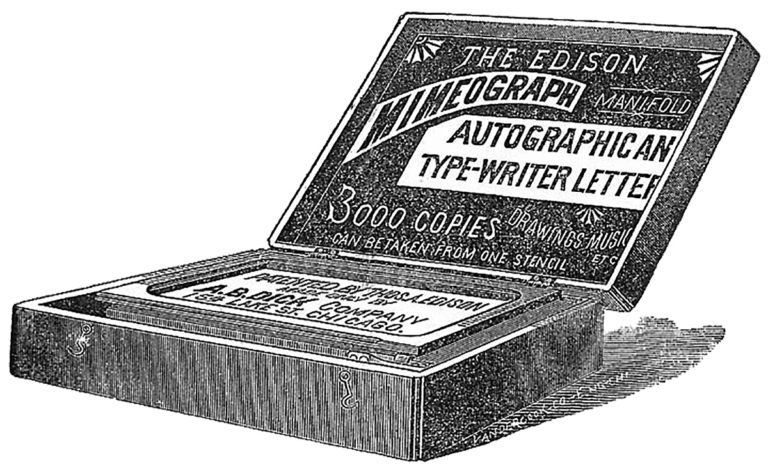 1
에디슨 등사판 타자기 모델 1 광고, 1889년; Early Office Museum 소장 이미지
1
에디슨 등사판 타자기 모델 1 광고, 1889년; Early Office Museum 소장 이미지
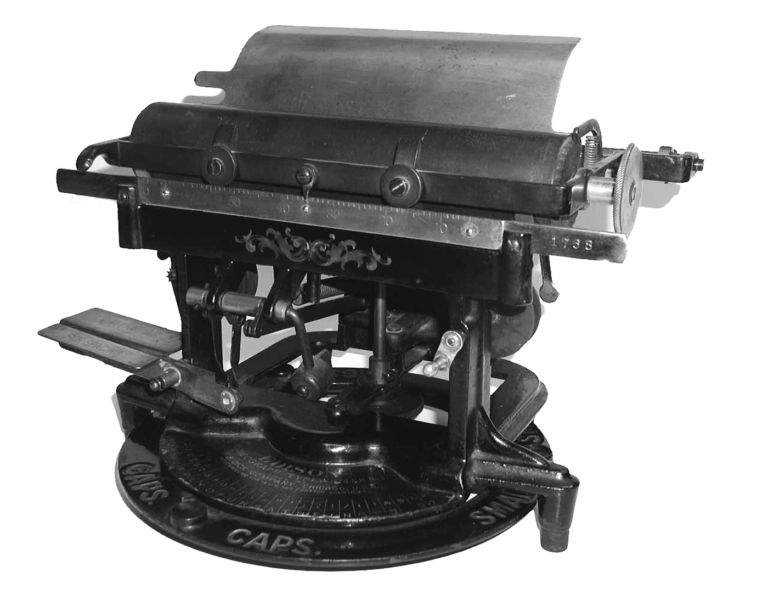 2
에디슨 등사판 타자기 모델 1, 1891년; Anthony Casillo 소장 이미지
2
에디슨 등사판 타자기 모델 1, 1891년; Anthony Casillo 소장 이미지
등사판 인쇄기는 스피릿 프린터, 헥토그래프와 함께 사무실이나 교실에서, 또는 정치 선전물이나 교회의 유인물을 인쇄하는 데 사용되었다. 테오도르 W. 아도르노의 “비판 이론(Critical Theory)”과 같은 이론서들도 초판은 등사판 인쇄기로 인쇄되었다.3 보스턴 대학교의 역사, 철학 및 정치학 교수인 제임스 슈미트(James Schmidt)는 이에 대해 다음과 같이 서술했다. “그 제목 [Philosophische Fragmente]은 독특한 보급 방식이 함축하는 바를 고백했다. 여기에는 불완전하고 어쩌면 심지어 모순적일 수도 있는 단편들의 모음이 있었고, 이는 출판 산업의 더 전통적인 산물과는 사뭇 다른 정체성을 가지고 있었다.” 4 이후에는 초창기 팬진(fanzine) 또한 흔하게 쓰이고 저렴했던 이 기술을 사용하여 인쇄되었다. 1960년대 후반에 등사판 인쇄기, 알코올 프린터, 헥토그래프는 점차 복사기로 대체되었다.5 이처럼 등사판 인쇄기는 그동안 존재했던 많은 발명품들의 집합체였다.
현재는 파산한 “A. B. Dick Company”6는 1880년대에 토마스 알바 에디슨(Thomas Alva Edison)으로부터 인쇄 특허에 대한 일부 마케팅 권한을 사들여 이 기술을 앞서 언급한 등사판 인쇄(mimeography)로 발전시켰다.
전기 및 전기 공학을 전문으로 하던 발명가이자 기업가인 에디슨7은 이미 그의 발명품들을 통해 명성을 얻고 있었다. 1875년, 에디슨은 전신 기술 작업에서 영감을 받아 전기 펜(electric pen)을 개발하기 시작했고, 전기 인쇄 및 복사 기술 발전의 토대를 마련했다.8
전기 펜은 에디슨이 대규모 시장에 출시한 첫 번째 제품이었다. 펜 안의 전기적으로 움직이는 바늘은 글씨를 쓰거나 그림을 그릴 때 원지(template)에 구멍을 뚫고, 이 원지는 나중에 복제용 원본으로 사용될 수 있다.9
A. B. Dick Company의 첫 생산 준비 제품은 1887년 “Model 0″이라는 이름으로 판매되었으며10, 가격은 12달러였다. 이를 요즘 환율로 바꾸면 2017년 기준 약 294.85달러에 해당한다.1112
 1
1871년에 등록된 토마스 에디슨의 1884년 전동 타자기 특허 (US 295 990)
1
1871년에 등록된 토마스 에디슨의 1884년 전동 타자기 특허 (US 295 990)
 2
S. F. 오라일리의 1891년 전기 펜 특허 (US 295,990). 그는 1880년대 중반에 문신 작업도 시작했으며 전시회도 기획했다.
2
S. F. 오라일리의 1891년 전기 펜 특허 (US 295,990). 그는 1880년대 중반에 문신 작업도 시작했으며 전시회도 기획했다.
 3
1891년에 등록된 유지니오 데 주카라토의 스텐실 제작 특허 (US 498 149). 이 발명은 1874년에 만들어졌다.
3
1891년에 등록된 유지니오 데 주카라토의 스텐실 제작 특허 (US 498 149). 이 발명은 1874년에 만들어졌다.
1887년에는 처음으로 평판형 등사기가 사용되었지만, 이후 회전식 실린더 기계로 대체되었다. 이는 헝가리 발명가 데이비드 게스테트너13의 이름을 따서 명명된 영국 Gestetner 사의 모델들과 같이 “Cylostyle”이라는 이름으로도 판매되었다.14
이 기계는 처음으로 종이를 평판에 놓고 회전하는 잉크 롤러 아래로 통과시키는 방식을 사용했다. 이제는 항상 한 장의 종이에만 인쇄하는 대신, 페이지들이 롤러를 통해 기계 안으로 공급되었고, 더 자동화되고 빠른 복제가 가능해졌다. 당시 게스테트너는 비엔나 증권거래소에서 일하며 매일 주식 시장 보고서를 작성해야 했다. 이런 환경에서 그는 종이 대신 왁스 스텐실에 글씨를 쓰고 이를 마스터 원본으로 사용하는 최초의 복사기를 개발했다. 이후 런던으로 건너간 그는 1881년 “Gestetner Cyclograph Company”를 설립하여 자신이 고안한 방식을 위한 원지와 펜을 제작했다. 그는 이 공정을 더욱 발전시켜 1890년에는 시간당 1200매를 인쇄할 수 있게 되었다. 그가 1881년 특허를 낸 ‘Cyclostyle’를 사람들은 게스테트너(Gestetner)로 불렀다.
The process that is underlying Cyclostyle is always similar: Waxed papers are perforated before printing with a thin pen so that color comes through the paper when printed on. The most interesting fact about David Gestetner’s machines was that they were much better equipped than the American variants that existed at the time: while American mimeos distributed paint using internal brushing and centrifugal force, David Gestetner used the far more sophisticated system of “wavering roles.” In addition, the Gestetner machines also had more sophisticated methods to improve the registration of color separations, which was well suited for two- and three-color mimeograph work.15
Finally, in 1906, the Gestetner plants in Tottenham, north of London, underlined the reach of this invention16, long before 1929, when none other than the young American industrial designer Raymond Loewy was hired to improve the mimeograph’s appearance and branding.17
Meanwhile, the A.B. Dick Company was able to sell about 20.000 devices in the United States alone until 1889 and thus established the copying technology in companies and authorities of the then young nation, while Edison’s own devices were considered too technical and thus he was able to sell far fewer devices.18
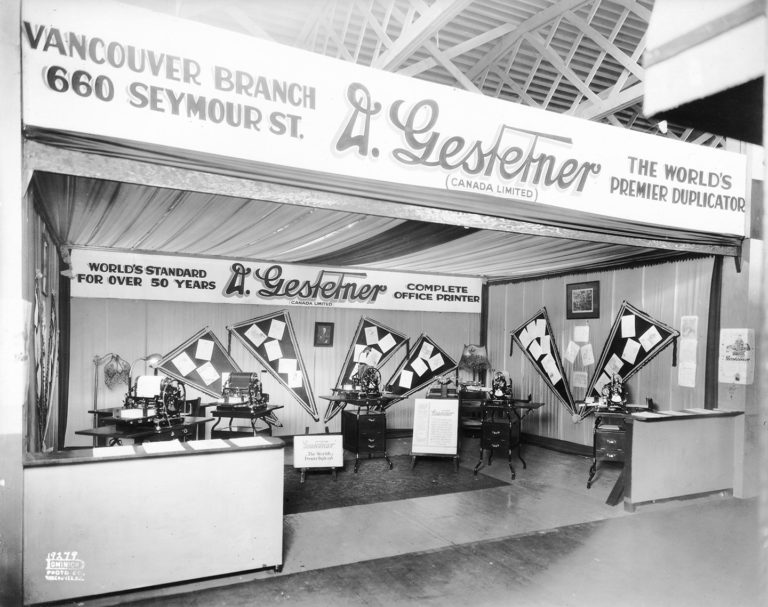 1
Exhibition of Gestetner devices, 1932; Image owned by the Pacific National Exhibition Fund
1
Exhibition of Gestetner devices, 1932; Image owned by the Pacific National Exhibition Fund
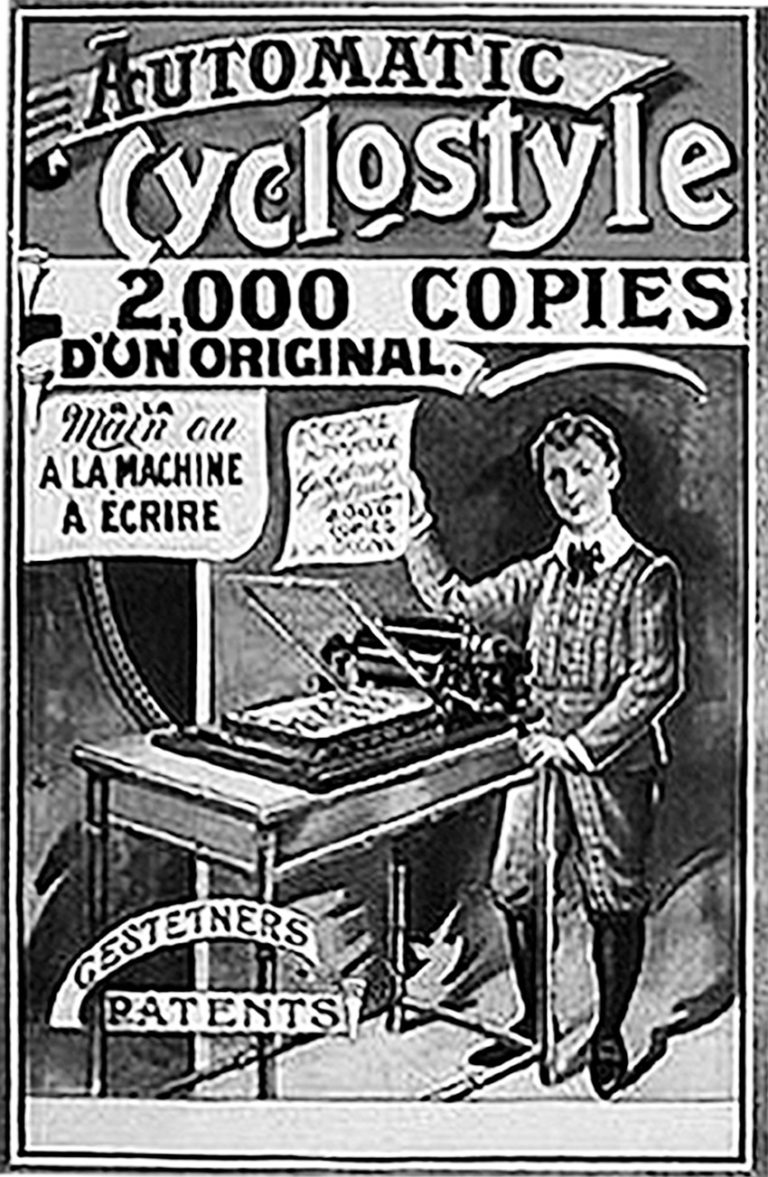 2
Gestetner Automatic Cyclostyle (French advertising for the British hectograph), around 1900; Picture owned by the Early Office Museum
2
Gestetner Automatic Cyclostyle (French advertising for the British hectograph), around 1900; Picture owned by the Early Office Museum
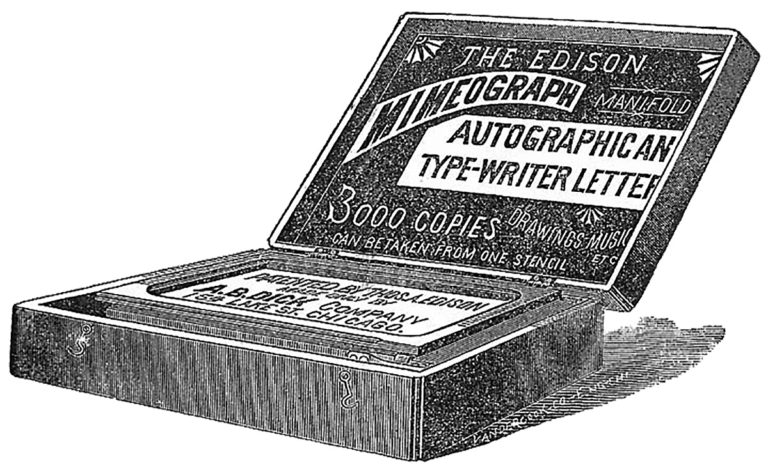 3
Advertising for the Holcomb Transfer Tablet Hectographers (1876); Picture owned by the Early Office Museum
3
Advertising for the Holcomb Transfer Tablet Hectographers (1876); Picture owned by the Early Office Museum
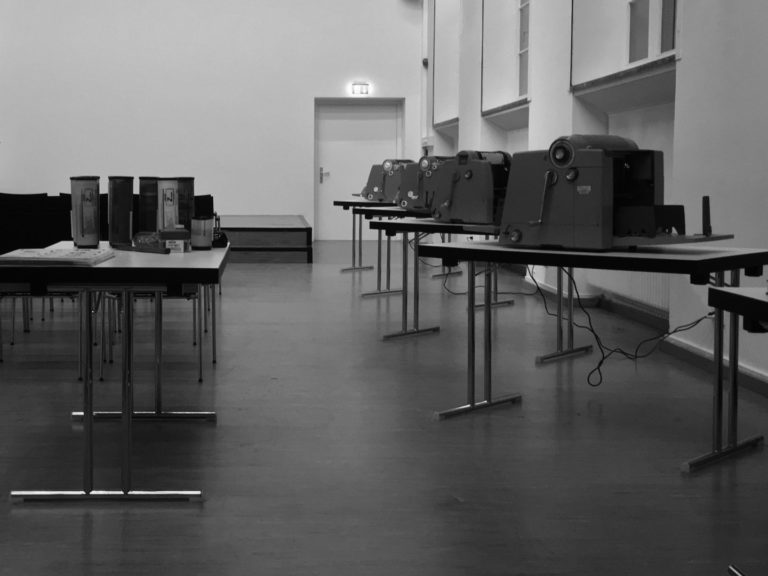 1
A series of Gestetner models 366 and 420 at a workshop with Erwin Blok, a restorer of old mimeographs at the Stuttgart State Academy of Fine Arts. Today these are operated with colors of the company RISO.
1
A series of Gestetner models 366 and 420 at a workshop with Erwin Blok, a restorer of old mimeographs at the Stuttgart State Academy of Fine Arts. Today these are operated with colors of the company RISO.
 2
A Gestetner Mimeograph restored by Erwin Blok during the printing process
2
A Gestetner Mimeograph restored by Erwin Blok during the printing process